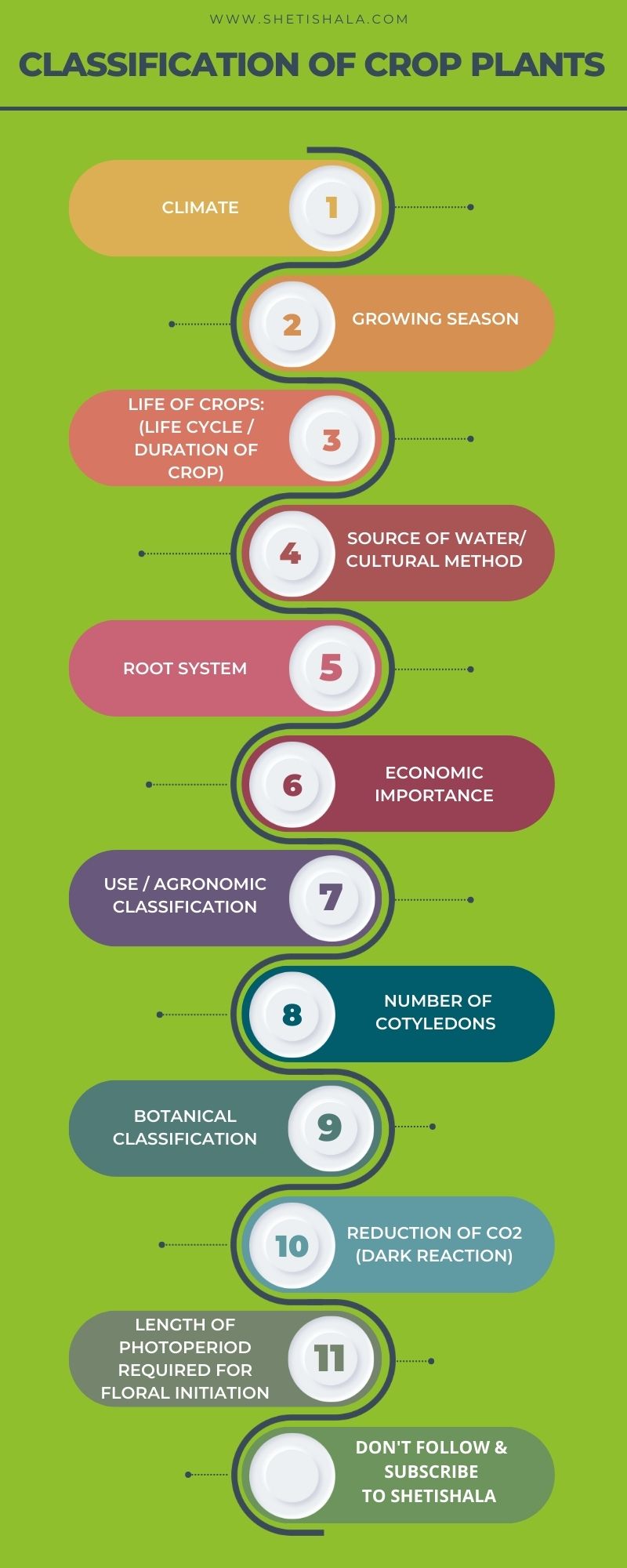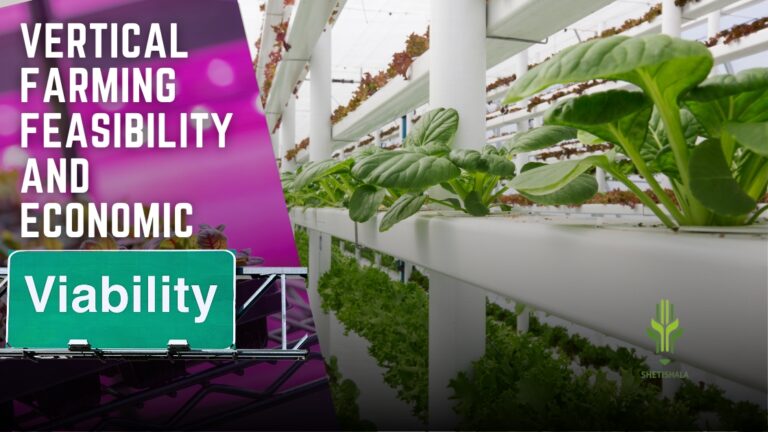Classification of crop plants involves categorizing them based on various criteria such as their botanical characteristics, economic importance, agronomic use, and environmental requirements.
A crop is an organism grown or harvested to obtain yield.

According to the natural system, the plant kingdom has been divided into two divisions: Cryptogams and Phanerogams. Phanerogams are further divided into two subdivisions: Angiosperms and Gymnosperms. Angiosperms are further divided into two classes: Monocots and Dicots. These classes are further subdivided into orders, orders into families, families into genera and species, and sometimes species into varieties.
Importance of classifying crop plants:
To become acquainted with crops.
To understand the requirements of soil and water for different crops.
To assess the adaptability of crops.
To understand the growing habits of crops.
To understand the climatic requirements of different crops.
To assess the economic produce of the crop plant and its use.
To determine the growing season of the crop, etc.
Classification of Crop Plants in more than one way, as listed below:

A. CLIMATE:
Tropical:
Crops that thrive in warm and hot climates, such as rice, sugarcane, and jowar.
Temperate:
Crops that require cool climates, including wheat, oats, gram, and potatoes.
B. GROWING SEASON:
Kharif / Rainy / Monsoon crops:
Crops cultivated during the monsoon months from June to October, requiring warm, wet weather during their major growth period and shorter day length for flowering. Examples include cotton, rice, jowar, and bajra.
Rabi / Winter crops:
Crops grown in the winter season from October to March, needing cold, dry weather for significant growth and longer day length for flowering. Examples are wheat, gram, linseed, and safflower.
Zaid / Summer crops:
Crops cultivated in the summer months from March to June, thriving in warm weather during their major growth period and longer day length for flowering. Examples include summer groundnut, watermelon, muskmelon, cucumber, pumpkins, and gourds.
C. LIFE OF CROPS: (LIFE CYCLE / DURATION OF CROP)
Seasonal crops:
Crops that complete their life cycle within one season, whether Kharif, Rabi, or summer, such as rice, jowar, and wheat.
Two seasonal crops:
Crops that complete their life cycle over two seasons, such as cotton, turmeric, arhar (L.D.), and ginger.
Annual crops:
Crops that require one full year to complete their life cycle, such as sugarcane.
Biennial crops:
Crops that grow in one year, flower, fruit, and perish the next year, for example, banana and papaya.
Perennial crops:
Crops that live for several years, including fruit crops like orange, mango, and guava.
D. SOURCE OF WATER/ CULTURAL METHOD:
Rainfed:
Crops that rely solely on rainwater for growth, such as jowar, bajra, mung, and udid.
Irrigated crops:
Crops that grow with the assistance of irrigation water, like cotton, chili, banana, and sugarcane.
E. Root system:

Tap-rooted:
Crops whose main root delves deep into the soil, such as cotton and fur.
Adventitious / Fibrous rooted:
Crops with fibrous roots that are shallow and spreading, including cereal crops like wheat, rice, jowar, and bajra.
F. Economic Importance:
Cash crop:
Grown primarily for earning money, such as cotton and sugarcane.
Food crop:
Cultivated to produce food grain for the population and fodder for cattle, examples include jowar, wheat, and rice.
G. AGRONOMIC CLASSIFICATION:
Grain crops:
These may be cereals or millets. Cereals are cultivated grasses grown for their edible starchy grains. Generally, cereals with larger grains serve as staple food, such as rice, jowar, wheat, maize, and barley. Millets, characterized by smaller grains, are of minor importance as food, such as bajra and ragi.
Pulses / Legume crops:
These are seeds of leguminous crop plants used as food. When split, they produce dal, which is rich in protein, examples include mung, udid, tur, and gram.
Forage crops:
These refer to vegetative matter, fresh or preserved, used as food for animals. Examples include fodder crops like jowar, maize, bajra, lucerne, berseem, and cowpea.
Root crops:
These crops produce economic yield from their roots, such as sugarbeet, carrot, and turnip.
Tuber crops:
These crops have edible portions that are short, thickened underground stems, for example, potatoes.
Fiber crops:
Grown for their fiber yield, obtained from seeds (e.g., cotton) or stem/bark (e.g., jute, mesta, roselle, sanhemp, and flax).
Sugar crops:
Grown for sugar production, examples include sugarcane and sugar beet.
Starch crops:
Cultivated for starch production, such as tapioca, potato, and sweet potato.
Oilseed crops:
These seeds are rich in fatty acids and are used to extract vegetable oil for various purposes, including groundnut, mustard, sunflower, safflower, linseed, castor, and soybean.
Drug crops:
Used for preparing medicines, for instance, tobacco, mint, and pyrethrum.
Spices & condiments / Spice crops: These crops or their products are used to flavor, enhance taste, and sometimes add color to fresh or preserved food, examples include ginger, garlic, chili, fenugreek, cumin, onion, and coriander.
Vegetable crops:
These may be leafy or fruit vegetables, such as spinach, fenugreek, squash, brinjal, and tomato.
Green manure crops: Grown and incorporated into the soil to increase soil fertility, for instance, sanhemp and dhainca.
H. NUMBER OF COTYLEDONS:

Monocots or Monocotyledonous:
Crops that have one cotyledon in the seed, such as all cereals and millets.
Dicots or Dicotyledonous:
Crops that have two cotyledons in the seed, for example, all legumes and pulses.
I. BOTANICAL CLASSIFICATION:
Field crops belong to the Spermatophyta group, where reproduction is carried out by seeds. Common crop plants belong to the subdivision Angiosperms, where ovules are enclosed in an ovary wall. Angiosperms are further divided into two classes: Monocotyledonous and Dicotyledonous. These are further subdivided into orders, families, genera, species, and varieties.
Family: Examples
Gramineae / Poaceae: Jowar, Bajra, RiceLeguminoseae / Fabaceae: Gram, Peas, Tur, Mung, etc.
Cruciferae: Mustard, Rapeseed, Cabbage, Cauliflower, Turnip, Radish
Cucurbitaceae: Watermelon, Muskmelon, Bitter gourd, Pumpkin, Ridge gourd, Cucumber
Liliaceae: Onion, Garlic
Solanaceae: Potato, Brinjal, Chili, Tomato, Tobacco
Malvaceae: Cotton, Roselle (Ambadi), Bhendi (Lady’s finger)
Compositae / Asteraceae: Sunflower, Safflower, Niger, Lettuce
Convolvulaceae: Sweet Potato
Euphorbiaceae: Castor, Tapioca
Zingiberaceae: Ginger, Turmeric
Linaceae: Linseed
Tiliaceae: Jute
Umbelliferae: Carrot, Cumin, Coriander
Pedaliaceae: Sesamum
Onagraceae: Singhara
J. REDUCTION OF CO2 (DARK REACTION):
Crops can be classified based on the type of photosynthesis as:
C3 plants:
These plants produce three-carbon compounds as the initial product of carbon assimilation. The enzyme responsible for primary carboxylation is ribulose-1,5-bisphosphate carboxylase. C3 plants exhibit high levels of photorespiration and have lower water use efficiency compared to other types. Examples include rice, soybean, wheat, groundnut, barley, cotton, oats, sunflower, rye, potato, sweet potato, tomato, and sugarbeet.
C4 plants:
Primary carbon fixation in these plants yields four-carbon compounds, such as malic acid or aspartic acid. The enzyme phosphoenolpyruvate carboxylase (PEP carboxylase) is responsible for carboxylation. C4 plants have negligible photorespiration, higher photosynthetic rates compared to C3 plants under similar stomatal opening conditions, and are more drought-resistant. Examples include sorghum, maize, Napier grass, pearl millet, and sugarcane.
CAM plants (Crassulacean Acid Metabolism plants):
These plants open their stomata at night, fixing large amounts of CO2 as malic acid, which is stored in vacuoles. During the day, when stomata are closed, CO2 is released through the breakdown of malic acid. CAM plants exhibit minimal transpiration and high water use efficiency, making them highly drought-resistant. Examples include pineapple, sisal, and agave.
K. LENGTH OF PHOTOPERIOD REQUIRED FOR FLORAL INITIATION:
Most plants are influenced by the relative length of day and night, especially for floral initiation. This effect of light on plants is known as photoperiodism. Depending on the length of photoperiod required for floral initiation, plants are classified as:

Short-day plants:
Flower initiation in short-day plants occurs when the days are short (typically less than 10 hours), examples include tropical crops like rice, sorghum, green gram, and black gram.
Long-day plants:
These plants require comparatively long days, usually more than 14 hours, for floral initiation. Examples include wheat, barley, oats (temperate crops). Such plants exhibit more vegetative growth when the days are short.
Day-neutral plants:
These plants do not require either long or short dark periods. Photoperiod does not have much influence on phasic changes in these plants. Examples include cotton and sunflower.
The rate of flowering initiation depends on the duration of the photoperiod. Short-day plants initiate flowering more rapidly when the days are shorter, while long-day plants initiate flowering more rapidly when the days are longer.




